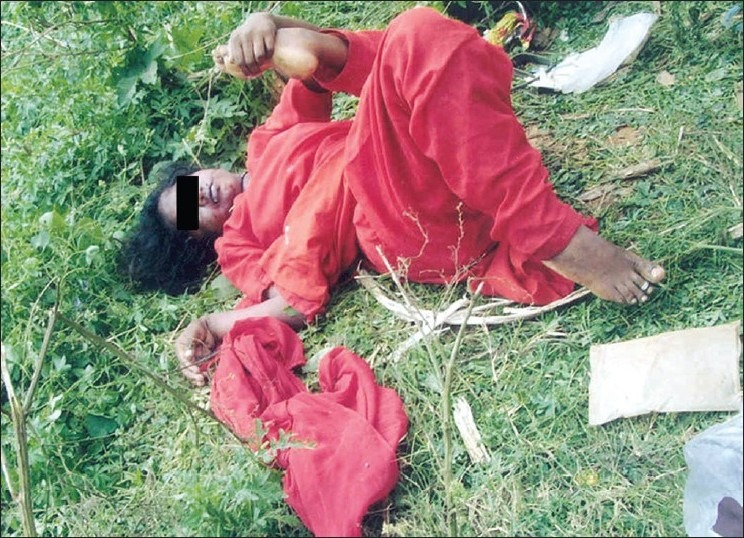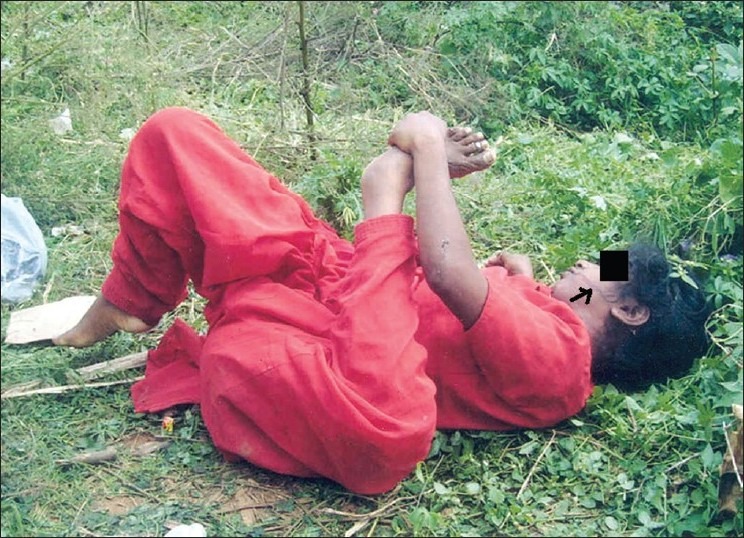Abstract
We report a case in which the dead body was found with rigor mortis in an unusual position. The dead body was lying on its back with limbs raised, defying gravity. Direction of the salivary stains on the face was also defying the gravity. We opined that the scene of occurrence of crime is unlikely to be the final place where the dead body was found. The clues were revealing a homicidal offence and an attempt to destroy the evidence. The forensic use of ‘rigor mortis in an unusual position’ is in furthering the investigations, and the scientific confirmation of two facts - the scene of death (occurrence) is different from the scene of disposal of dead body, and time gap between the two places.
Keywords: Crime scene, disposal of dead body, homicide, rigor mortis, scene of occurrence, unusual position
INTRODUCTION
Rigor mortis is a postmortem change resulting in the stiffening of the body muscles due to chemical changes in their myofibrils. Rigor mortis helps in estimating the time since death as well to ascertain if the body had been moved after death.[1] Position of the body in which the rigor mortis is established is indicative of the position of the body at the time of death, unless the position is disturbed by external forces or putrefaction.
Even the body posture at the scene of death, sometimes, needs correct forensic interpretations.[2] A dead body without decomposition, lying on its back with limbs raised in the air, indicates that the body reached full rigidity elsewhere.[3,4]
Experienced forensic pathologists, invariably, have seen rigor mortis in unusual positions, but there are few descriptions of it in the forensic literature. It is rare to find a dead body in an unusual position, far away from the scene of occurrence of crime. We report this case, where the dead body was lying on its back with raised limbs defying the gravity, due to rigor mortis.
CASE REPORT
Autopsy
Dead body of an unknown female aged about 25 years was brought for medico legal autopsy with an unknown history, but with the suspicion of a murder. Autopsy was carried out after 3 h from the time of finding the dead body in an isolated place at the suburbs of Bangalore, India. The body was found in an unusual position at about 7 am, when the temperatures at that place ranged between 21°C and 27°C in the past 6 h.
During autopsy, we found rigor mortis, well established, all over the body, in an unusual position, as seen in the photographs taken at the scene, where the dead body was found [Figures 1–2]. Postmortem hypostasis was found to be fixed on the back of the trunk of the dead body. There were no signs of decomposition. A horizontal ligature mark was seen completely encircling the neck. Contusions were present on the either sides in and around the muscles. No other injuries were noted elsewhere on the body. Autopsy findings were consistent with a death due to ligature strangulation. Time since death was estimated to be between 6 and 12 h. The investigations in this case had not proceeded further because the victim was unidentified. The police officer provided us with the photographs of the scene where the dead body was found in an unusual position [Figures 1 and Figure 2.
Figure 1.

Unusual position with the right foot defying the gravity
Figure 2.

Direction of the salivary stains on the face, toward the left, defying the gravity
Observations from the photographs
The location was an open ground with a flat surface. Head and trunk of the victim were resting on the back with the face slightly tilted toward the right. Right upper limb (flexion at elbow and wrist) rested on the ground [Figure 1]. Left upper limb (flexed at shoulder and elbow) and the left lower limb (flexed at hip and knee) lied raised from the ground level and were held up high because of, what appears as the feet being grasped by the hand. The right leg (flexed at hip and knee) lied elevated from the ground level defying the gravity [Figures 1 and 2]. The direction of salivary dribbling from the mouth was directed toward the left side of the face [Figure 2].
Clues after considering the photographs
The scene of occurrence of death is unlikely to be the place where the dead body was found. The victim's dead body was disposed off, after positioning in an unusual way.
The dead body must have reached the final place, after about 2 h to a maximum of 6 h after the death.
The death is homicidal in nature.
DISCUSSION
In India, the inquest is carried out by the police, or the magistrate, or both. It is uncommon for a medical expert to be visiting the scene of crime. Most of the information gathered by the autopsy surgeon, prior to autopsy, is by the police. However, there are rare situations where the police will request the forensic experts to visit the scene of death.[5] There is also practice of providing photographs of the scene of death, whenever necessary, to the autopsy surgeon, as was done in this case.
The usual position after death is that of the supine position. The decedent's unusual posture after death, although could be seen in some cases; could contribute to several findings such as unusual postmortem staining.[2] Rigor mortis develops in the body after death, in whatever position the body is present during its onset.
Rigor mortis is a post mortem change which is better appreciated by touch than by seeing the photographs. Rigor mortis is usually measured manually by attempting to flex or extend each joint during autopsy.[6] Rigor mortis follows primary relaxation of the muscles; it is easily possible to change the position of body parts during this period, after which the position remains stable till the rigor mortis disappears. If the position of the dead body during the primary relaxation is unusual with flexion at some major joints, it will remain rigidly in the same position during the stage of rigor mortis. If the rigor mortis is the well established stage, the flexed limbs continue to stay flexed and will defy gravity, even when the support beneath them is missing. Unusual position in which the limbs are stiff and defy gravity could be due to putrefaction as well.[1] Stiffness due to rigor mortis can be differentiated from stiffness due to putrefaction. Dead bodies with moderate or advanced putrefaction will no longer have rigor mortis.[7] In the present case, the autopsy confirms that there was no decomposition, and the stiffness seen in the unusual position, even in the photographs, is due to rigor mortis.
The clue about the scene of death (occurrence)
In the present case, it can be presumed that dead body was positioned into an unusual posture, prior to the onset of the rigor mortis. Such an unusual positioning of the dead body is not possible at the flat surface, where the dead body was found disposed off; the dead body has originated from a different place, where the death occurred.
The flexion attitude seen in the major joints is either due to packing in a bag, bundling of the body, or putting it in a sitting like posture. These positions are most suitable for transporting the dead body, especially in a compact carrier, for disposal.
The direction of dried stains of salivary dribbling should have been toward the right side of the face vis-à-vis the body's position in its final resting location; the direction of the dribbling saliva toward the left side is defying the gravity. The dead body was in a differently tilted position earlier, compared to what is seen where the dead body was finally found. This adds on to the view that the dead body has originated from a different place.
Time between the original and final place
The onset and duration of rigor mortis is governed by several factors. Indian conditions are different, compared to the temperate countries, when time since death needs to be estimated. Indian textbooks report that, rigor mortis commences in 2-3 h, takes about 12 h to develop, persists for another 12 h, and takes about 12 h to pass off.[3,4] Rigor mortis can re-establish after rigor is broken and a significant rigidity can reappear if the breaking occurs before the process is complete.[8] Many factors such as exercise, cause of death, temperature and nourishment affect the onset or progress of rigor mortis of the whole body.[6] In the present case, where the rigor mortis is seen well established all over the body, after considering the usual possibilities, the dead body must have reached the place of disposal, from 2 to 6 h after the death (scene of occurrence).
Manner of death
We suggested that the manner of death, in most of its probabilities, is homicidal in nature. First justification is the cause of death being ligature strangulation (based on the complete autopsy carried out in this case), which is usually homicidal in nature.[9] Finally, there is the evidence of covering up of this incident by disposing the dead body at a far and lonely place; deaths other than those due to homicide, are less likely to be covered up by the visitors.
To conclude, the clues from the ‘rigor mortis in an unusual position’ are revealing a homicidal offence and an attempt to hide the evidence. Data about the scene of death is very helpful in providing vital clues for investigations. Visit to the scene of death is therefore recommended in cases without clear history or in cases needing more information. Unusual presentation of any case should be considered as a challenge requiring reasoning.
ACKNOWLEDGEMENT
We thank the Peenya Police Officers from Bangalore for providing the photographs. We also thank Dr.M.G.Shivaramu, Dr.Praveen.S, Dr.Pradeep.K.Saralaya and Dr.Naveenkumar, of Bangalore, for their valuable suggestions and support.
Footnotes
Source of Support: Nil.
Conflict of Interest: None declared.
REFERENCES
- 1.Gill JR, Landi K. Putrefactive Rigor: Apparent Rigor Mortis Due to Gas Distension. Am J Forensic Med Pathol. 2011;32:242–4. doi: 10.1097/PAF.0b013e3181dd17b9. [DOI] [PubMed] [Google Scholar]
- 2.Asamura H, Oki T, Masao O, Fukushima H. Unusual body posture after death leading to signs of strangulation. Am J Forensic Med Pathol. 2010;3:195–7. doi: 10.1097/PAF.0b013e3181cffff0. [DOI] [PubMed] [Google Scholar]
- 3.Reddy KS. The Essentials of Forensic medicine and Toxicology. 26th ed. Hyderabad: K. Saguna Devi; 2007. pp. 130–2. [Google Scholar]
- 4.Parikh CK. Parikh's textbook of medical jurisprudence, forensic medicine and toxicology. 6th ed. Delhi: CBS Publishers; 1999. pp. 3–16. [Google Scholar]
- 5.Kanchan T, Rastogi P, Menezes RG, Nagesh KR. Apparent Partial Hanging. Am J Forensic Med Pathol. 2010;31:376–7. doi: 10.1097/PAF.0b013e3181f69c72. [DOI] [PubMed] [Google Scholar]
- 6.Kobayashi M, Takatori T, Nakajima M, Saka K, Iwase H, Nagao M, et al. Does the sequence of onset of rigor mortis depend on the proportion of muscle fibre types and on intra-muscular glycogen content? Int J Legal Med. 1999;112:167–71. doi: 10.1007/s004140050225. [DOI] [PubMed] [Google Scholar]
- 7.DiMaio VJ, DiMaio DJ. Forensic Pathology. 2nd ed. Boca Raton, FL: CRC Press; 2001. p. 565. [Google Scholar]
- 8.Krompecher T, Gilles A, Brandt-Casadevall C, Mangin P. Experimental evaluation of rigor mortis: IX. The influence of the breaking (mechanical solution) on the development of rigor mortis. Forensic Sci Int. 2008;176:157–62. doi: 10.1016/j.forsciint.2007.08.004. [DOI] [PubMed] [Google Scholar]
- 9.Verma SK, Aggarwal NK, Kohli A. Accidental ligature strangulation deaths in East Delhi (India) Med Sci Law. 2005;45:47–51. doi: 10.1258/rsmmsl.45.1.47. [DOI] [PubMed] [Google Scholar]


